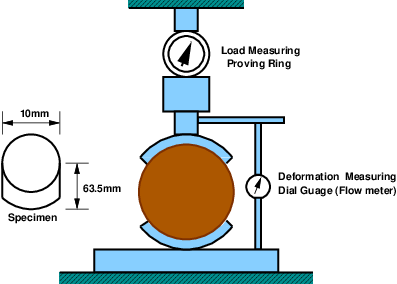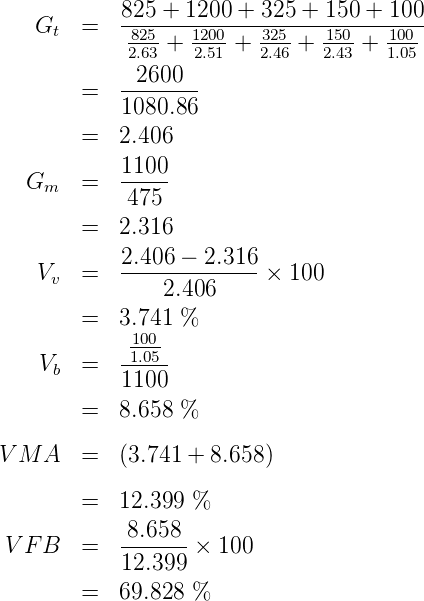
The mix design (wetmix) determines the optimum bitumen content. This is preceded by the dry mix design discussed in the previous chapter. There are many methods available for mix design which vary in the size of the test specimen, compaction, and other test specifications. Marshall method of mix design is the most popular one and is discussed below.
The Marshall stability and flow test provides the performance prediction measure for the Marshall mix design method. The stability portion of the test measures the maximum load supported by the test specimen at a loading rate of 50.8 mm/minute. Load is applied to the specimen till failure, and the maximum load is designated as stability. During the loading, an attached dial gauge measures the specimen’s plastic flow (deformation) due to the loading. The flow value is recorded in 0.25 mm (0.01 inch) increments at the same time when the maximum load is recorded. The important steps involved in marshal mix design are summarized next.
Approximately 1200gm of aggregates and filler is heated to a temperature of 175 - 190oC. Bitumen is heated to a temperature of 121 - 125oC with the first trial percentage of bitumen (say 3.5 or 4% by weight of the mineral aggregates). The heated aggregates and bitumen are thoroughly mixed at a temperature of 154 - 160oC. The mix is placed in a preheated mould and compacted by a rammer with 50 blows on either side at temperature of 138oC to 149oC. The weight of mixed aggregates taken for the preparation of the specimen may be suitably altered to obtain a compacted thickness of 63.5+/-3 mm. Vary the bitumen content in the next trial by +0.5% and repeat the above procedure. Number of trials are predetermined. The prepared mould is loaded in the Marshall test setup as shown in the figure 1.
The properties that are of interest include the theoretical specific gravity Gt, the bulk specific gravity of the mix Gm, percent air voids V v, percent volume of bitumen V b, percent void in mixed aggregate VMA and percent voids filled with bitumen VFB. These calculations are discussed next. To understand these calculation a phase diagram is given in Figure 2.
Theoretical specific gravity Gt is the specific gravity without considering air voids, and is given by:
 | (1) |
where, W1 is the weight of coarse aggregate in the total mix, W2 is the weight of fine aggregate in the total mix, W3 is the weight of filler in the total mix, Wb is the weight of bitumen in the total mix, G1 is the apparent specific gravity of coarse aggregate, G2 is the apparent specific gravity of fine aggregate, G3 is the apparent specific gravity of filler and Gb is the apparent specific gravity of bitumen,
The bulk specific gravity or the actual specific gravity of the mix Gm is the specific gravity considering air voids and is found out by:
 | (2) |
where, Wm is the weight of mix in air, Ww is the weight of mix in water, Note that Wm - Ww gives the volume of the mix. Sometimes to get accurate bulk specific gravity, the specimen is coated with thin film of paraffin wax, when weight is taken in the water. This, however requires to consider the weight and volume of wax in the calculations.
Air voids V v is the percent of air voids by volume in the specimen and is given by:
 | (3) |
where Gt is the theoretical specific gravity of the mix, given by equation 26.1. and Gm is the bulk or actual specific gravity of the mix given by equation 26.2.
The volume of bitumen V b is the percent of volume of bitumen to the total volume and given by:
 | (4) |
where, W1 is the weight of coarse aggregate in the total mix, W2 is the weight of fine aggregate in the total mix, W3 is the weight of filler in the total mix, Wb is the weight of bitumen in the total mix, Gb is the apparent specific gravity of bitumen, and Gm is the bulk specific gravity of mix given by equation 26.2.
Voids in mineral aggregate V MA is the volume of voids in the aggregates, and is the sum of air voids and volume of bitumen, and is calculated from
 | (5) |
where, V v is the percent air voids in the mix, given by equation 26.3. and V b is percent bitumen content in the mix, given by equation 26.4. (4).
Voids filled with bitumen V FB is the voids in the mineral aggregate frame work filled with the bitumen, and is calculated as:
 | (6) |
where, V b is percent bitumen content in the mix, given by equation 26.4. and V MA is the percent voids in the mineral aggregate, given by equation 26.5.
Marshall stability of a test specimen is the maximum load required to produce failure when the specimen is preheated to a prescribed temperature placed in a special test head and the load is applied at a constant strain (5 cm per minute). While the stability test is in progress dial gauge is used to measure the vertical deformation of the specimen. The deformation at the failure point expressed in units of 0.25 mm is called the Marshall flow value of the specimen.
It is possible while making the specimen the thickness slightly vary from the standard specification of 63.5 mm. Therefore, measured stability values need to be corrected to those which would have been obtained if the specimens had been exactly 63.5 mm. This is done by multiplying each measured stability value by an appropriated correlation factors as given in Table below.
| Volume of | Thickness | Correction |
| specimen | of specimen | Factor |
| (cm3) | (mm) | |
| 457 - 470 | 57.1 | 1.19 |
| 471 - 482 | 68.7 | 1.14 |
| 483 - 495 | 60.3 | 1.09 |
| 496 - 508 | 61.9 | 1.04 |
| 509 - 522 | 63.5 | 1.00 |
| 523 - 535 | 65.1 | 0.96 |
| 536 - 546 | 66.7 | 0.93 |
| 547 - 559 | 68.3 | 0.89 |
| 560 - 573 | 69.9 | 0.86 |
The average value of the above properties are determined for each mix with different bitumen content and the following graphical plots are prepared:
Determine the optimum binder content for the mix design by taking average value of the following three bitumen contents found form the graphs obtained in the previous step.
The stability value, flow value, and V FB are checked with Marshall mix design specification chart given in Table below. Mixes with very high stability value and low flow value are not desirable as the pavements constructed with such mixes are likely to develop cracks due to heavy moving loads.
| Test Property | Specified Value |
| Marshall stability, kg | 340 (minimum) |
| Flow value, 0.25 mm units | 8 - 17 |
| Percent air voids in the mix V v% | 3 - 5 |
| Voids filled with bitumen V FB% | 75 - 85 |
The specific gravities and weight proportions for aggregate and bitumen are as under for the preparation of Marshall mix design. The volume and weight of one Marshall specimen was found to be 475 cc and 1100 gm. Assuming absorption of bitumen in aggregate is zero, find V v, V b, V MA and V FB;
| Item | A_1 | A_2 | A_3 | A_4 | B |
| Wt (gm) | 825 | 1200 | 325 | 150 | 100 |
| Sp. Gr | 2.63 | 2.51 | 2.46 | 2.43 | 1.05 |

The results of Marshall test for five specimen is given below. Find the optimum bitumen content of the mix.
| Bitumen | Stability | Flow | V v | V FB | Gm |
| content | (kg) | (units) | (%) | (%) | |
| 3 | 499.4 | 9.0 | 12.5 | 34 | 2.17 |
| 4 | 717.3 | 9.6 | 7.2 | 65 | 2.21 |
| 5 | 812.7 | 12.0 | 3.9 | 84 | 2.26 |
| 6 | 767.3 | 14.8 | 2.4 | 91 | 2.23 |
| 7 | 662.8 | 19.5 | 1.9 | 93 | 2.18 |
Solution Plot the graphs and find bitumen content corresponding to
The optimum bitumen extent is the average of above = 4.33 percent.
Marshal stability test is the performance prediction measure conducted on the bituminous nix. The procedure consists of determination of properties of mix, Marshal stability and flow analysis and finally determination of optimum bitumen content. The concept of phase diagram is used for the calculations.
I wish to thank several of my students and staff of NPTEL for their contribution in this lecture. I also appreciate your constructive feedback which may be sent to tvm@civil.iitb.ac.in
Prof. Tom V. Mathew
Department of Civil Engineering
Indian Institute of Technology Bombay, India
____________________________________________________________________________________________
Fri May 24 16:23:19 IST 2019